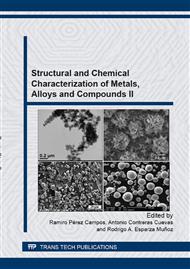[1]
R. Bao, X. Zhang, N. A. Yahaya, Evaluating stress intensity factors due to weld residual stresses by the weight function and finite element methods, Engineering Fracture Mechanics 77 (2010) 2550–2566.
DOI: 10.1016/j.engfracmech.2010.06.002
Google Scholar
[2]
S. Pratihar, M. Turski, L. Edwards, P.J. Bouchard, Neutron diffraction residual stress measurements in a 316L stainless steel bead-on-plate weld specimen, International Journal of Pressure Vessels and Piping 86 (2009) 13–19.
DOI: 10.1016/j.ijpvp.2008.11.010
Google Scholar
[3]
C. Ohms, R.C. Wimpory, D.E. Katsareas, A.G. Youtsos, NET TG1: Residual stress assessment by neutron diffraction and finite element modeling on a single bead weld on a steel plate, International Journal of Pressure Vessels and Piping 86 (2009) 63–72.
DOI: 10.1016/j.ijpvp.2008.11.009
Google Scholar
[4]
J. Lu and D. Retraint, A review of recent developments and applications in the field of X-ray diffraction for residual stress studies, Journal of Strain Analysis 33 (1998) 127-136.
DOI: 10.1243/0309324981512869
Google Scholar
[5]
F.A. Kandil, J.D. Lord, A.T. Fry and P.V. Grant, A review of residual stress measurement methods -A guide to technique selection, NPL Materials Centre Queens Road Teddington, Middlesex, UK, 2001.
Google Scholar
[6]
A. Skouras, A. Paradowska, M.J. Peel, P.E.J. Flewitt, M.J. Pavier, Residual stress measurements in a ferritic steel/In625 superalloy dissimilar metal weldment using neutron diffraction and deep-hole drilling, International Journal of Pressure Vessels and Piping 101 (2013) 143-53.
DOI: 10.1016/j.ijpvp.2012.11.002
Google Scholar
[7]
N.S. Rossinia, M. Dassistia, K.Y. Benyounisb and A.G. Olabib, Methods of measuring residual stresses in components, Materials and Design 35 (2012) 572-588.
Google Scholar
[8]
Q. Chen, W.G. Mao, Y.C. Zhou, C. Lu, Effect of Young's modulus evolution on residual stress measurement of thermal barrier coatings by X-ray diffraction, Applied Surface Science 256 (2010) 7311–7315.
DOI: 10.1016/j.apsusc.2010.05.071
Google Scholar
[9]
M. Chun Zhao, K. Yang, Y. Yin Shan, Comparison on strength and toughness behaviors of microalloyed pipeline steels with acicular ferrite and ultrafine ferrite, Materials Letters 57 (2003) 1496-1500.
DOI: 10.1016/s0167-577x(02)01013-3
Google Scholar
[10]
T. McGaughy, L. Boyles, The influence of weld repairs on changes in residual stress and fracture toughness in pipeline girth welds, Recent Advances in Structural Mechanics, ASME 1992; PVP 248:81-86.
Google Scholar
[11]
T. McGaughy, Significance of changes in residual stresses and mechanical properties due to SMAW repair girth welds in line pipe, Edison Welding Institute and Pipeline Research Council International, Inc. 1990; 1-18.
Google Scholar
[12]
M. Law, Residual stress measurements in coil, linepipe and girth welded pipe, Materials Science and Engineering A 437 (2006) 60-63.
DOI: 10.1016/j.msea.2006.04.062
Google Scholar
[13]
M. Mochizuki, Residual stress distribution depending on welding sequence in multi-pass welded joints with X-shaped groove, Journal of Pressure Vessel Technology 122 (2000) 27-32.
DOI: 10.1115/1.556142
Google Scholar
[14]
S. Nair, Residual stress generation and relaxation in butt-welded pipes, Journal of Pressure Vessel Technology 104 (1982) 188-192.
DOI: 10.1115/1.3264202
Google Scholar
[15]
T. Liang Teng, A study of residual stresses in multi-pass girth-butt welded pipes, International Journal of Pressure Vessels and Piping 74 (1997) 59-70.
DOI: 10.1016/s0308-0161(97)00091-4
Google Scholar
[16]
Y. Dong, Finite element modeling of residual stresses in austenitic stainless steel pipe girth welds, Welding Journal 76 (1997) 442-449.
Google Scholar
[17]
S. Vaidyanathan, Residual stresses due to circumferential welds, Journal of Engineering Materials and Technology 104 (1973) 233-237.
DOI: 10.1115/1.3443159
Google Scholar
[18]
E.F. Rybicki, The effect of pipe thickness on residual stresses due to girth welds, Journal of Pressure Vessel Technology 104 (1982) 204-209.
DOI: 10.1115/1.3264205
Google Scholar
[19]
P. Dong, Analysis of residual stresses at weld repairs, International Journal of Pressure Vessels and Piping 82 (2005) 258-269.
DOI: 10.1016/j.ijpvp.2004.08.004
Google Scholar
[20]
D. George, D.J. Smith, Through thickness measurement of residual stresses in a stainless steel cylinder containing shallow and deep weld repairs, International Journal of Pressure Vessels and Piping 82 (2005) 279-287.
DOI: 10.1016/j.ijpvp.2004.08.006
Google Scholar
[21]
P.J. Bouchard, Measurements of the residual stress in a stainless steel pipe girth weld containing long and short repairs, International J. of Press. Vessels and Piping 82 (2005) 299-310.
DOI: 10.1016/j.ijpvp.2004.08.008
Google Scholar
[22]
C.D. Elcoate, Three dimensional multi-pass weld simulations, International Journal of Pressure Vessels and Piping 82 (2005) 244-257.
DOI: 10.1016/j.ijpvp.2004.08.003
Google Scholar
[23]
P. Dong, Effect of repair weld length on residual stress distribution, Journal of Pressure Vessel Technology 124 (2002) 74-80.
DOI: 10.1115/1.1429230
Google Scholar
[24]
A.S. Oddy, Transformation plasticity and residual stresses in single-pass repair welds, Journal of Pressure Vessel Technology 114 (1992) 33-38.
DOI: 10.1115/1.2929009
Google Scholar
[25]
P. Dong, Welding residual stresses and effects on fracture in pressure vessel and piping components: A millennium review and beyond, J. of Press Vessel Technology 122 (2000) 329-338.
DOI: 10.1115/1.556189
Google Scholar
[26]
T. Lant, Review of weld repair procedures for low alloy steels designed to minimize the risk of future cracking, International Journal of Pressure Vessels and Piping 78 (2001) 813-818.
DOI: 10.1016/s0308-0161(01)00094-1
Google Scholar


